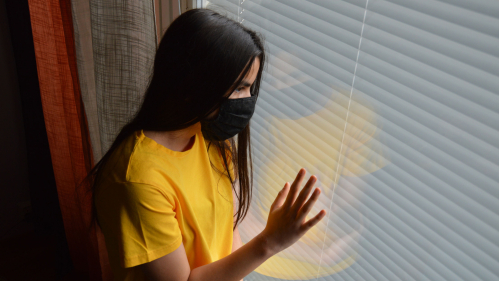Addressing Teen Mental Health During the Pandemic

Adults should validate teens’ feelings, help create structure and routine and be aware of when mental health treatment is needed, says Rutgers experts
It has been more than seven months since the pandemic initially shut schools, raising concerns about the mental health of adolescents, says Ann Murphy, an associate professor in the Department of Psychiatric Rehabilitation and Counseling Professions at Rutgers School of Health Professions.
As director of the Northeast and Caribbean Mental Health Technology Transfer Center, Murphy has been providing trainings and consultation services for school personnel across New Jersey, along with PJ Wenger, a senior training and consultation specialist at the Center who has been providing mental health first-aid trainings in schools. Murphy and Wenger discuss how the pandemic has impacted adolescents’ mental health and how adults can help.
How has the pandemic affected the mental health of adolescents?
Murphy: Adolescents rely heavily on connections with their peers. It’s an important part of their development. Social connections have been strained by the changes to in-person school and increased time at home. We know that social isolation and loneliness is linked with poorer mental health and higher rates of depression and anxiety. Surveys from early on in quarantine were already showing that more than one-third of adolescents were experiencing high levels of loneliness.
The ongoing uncertainty around when things will return to normal — and what that normal will look like — contributes to heightened anxiety for teens. For those whose family well-being has been negatively affected by COVID infection or death, unemployment and financial instability, there’s a greater risk for adverse mental health outcomes. There is also an enhanced risk for youth who live in homes with abuse and neglect during the quarantine. It is likely that there has been more exposure to violence during this time, but because 20 percent of reports of abuse are made by educators there has actually been a decrease in reports to child protective services, which is a concerning vulnerability. Additionally, substance use has increased for all age groups during the pandemic.
Wenger: Adolescents have experienced a loss of things that help contribute to their resiliency like school, clubs, sports, friends, extended family and community. Also, because of where they are developmentally, teens need help with regulation. Routines, schedules, clear expectations and knowing what to anticipate helps with this. While the pandemic took away a lot of the structure that helps with regulation, school and other safe activities can help.
We need to identify students at risk early. Mental health concerns among adolescents can look like: heightened arousal, mood changes, anxiety, worry, depression, lack of motivation, apathy about school and disrupted sleeping and eating.
Are all students ready to get back to in-person classes or has remote school been beneficial for some?
Murphy: For students who previously experienced school anxiety or bullying prior to the pandemic, remote learning has offered some relief. In fact, in some cases, mental health and school functioning have improved for these young people. However, this now makes returning to school even more difficult.
For students who weren’t anxious previously, they may be more anxious now because they’ve been accustomed to being home and they have been told that is the only place that’s really safe from the virus. We’ve spent the last several months telling students they can’t go out because it’s dangerous, which was necessary, but it is also understandable that they may now feel anxious about being around others and at school. This may be particularly challenging for young kids.
Wenger: These are some strategies to support students who are experiencing anxiety related to in-person school: Be honest and open in discussing the child’s feelings; provide reassurance that it is OK for them to be away from home if they are returning to school; check in with them frequently and listen to their concerns; help them focus on what they can control regarding the virus like hand washing, wearing face masks and practicing social distancing; and make sure they get enough sleep, eat well, get plenty of exercise and engage in play. Adults can set up ways for children to socialize safely with friends over the phone, by video chat or in outdoor spaces; teach them breathing exercises and practice them daily; and leave your child positive and encouraging notes.
What steps can parents and teachers take to help students who are struggling?
Murphy: Validate their feelings. Teachers have shared that when their students talk about things that are difficult, they try to refocus them on the positives. This can invalidate the student’s feelings and make them think the adult doesn’t understand. It’s important that we continue to recognize and verbalize back to students how challenging things are right now and how big the losses and changes feel to them.
If parents or teachers see students who are really struggling to the extent that it is impeding their ability to pay attention, complete work, sleep, eat, interact with family or friends or if they see a significant change in their behavior from what it has been, this may indicate a need to seek professional help.
Wenger: As much as possible, adults should maintain regular schedules as that can provide external support for teens who may have difficulty creating this regulation on their own.
Schools and teachers should consider formalizing a process that focuses on supporting student mental health and identifying students who may be struggling with mental health concerns. Some schools have instituted universal screening this year to try to assess the overall mental health status of their students and also identify students who may need additional support. Schools may also want to consider suicide prevention training and programming, stress management and social emotional learning curricula, and strategies to support positive connections among students, teachers and school staff to try to limit loneliness and the negative outcomes associated with prolonged loneliness.


